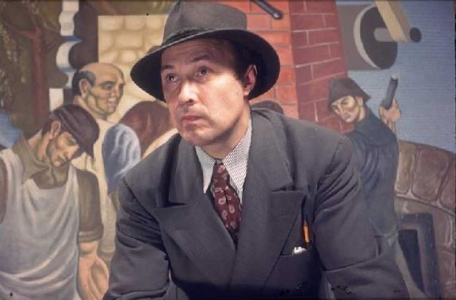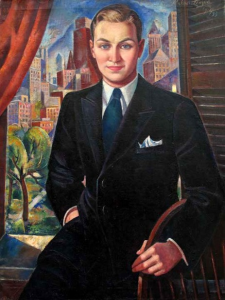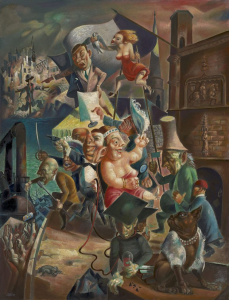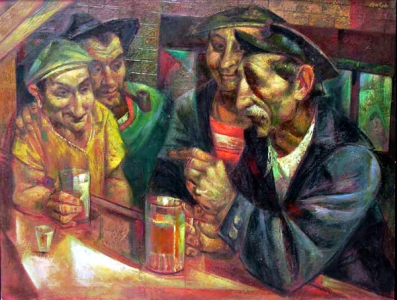
Biography
Michael Lenson was born in 1903 in Galich, Russia, one of seven brothers and a sister. One of his brothers was to become even more prominent figure on the American scene than Michael: that was the humorist Sam Levenson. The family emigrated to the United States in 1908. Michael attended the National Academy of Design in the 1920s, living in poverty with other New York artists until he won the Chaloner Prize in 1928, which enabled him to spend four years studying art in Europe.
In 1928 Lenson attended the Slade School of Art in London, then recognized as the best school in Europe for aspiring draftsmen. During his stay in London he learned something about mural painting by assisting the muralist Colin Gill, who had attained fame as a war artist in World War I. In 1930 Lenson moved to Paris to attend the Academie des Beaux-Arts. The remainder of his European stay was spent in visits to Italy, Spain and Netherlands. During this period his work was shown in the Goupil Galleries in London and at the Salon d'Automne and Salon d'Printemps in Paris (1928-1929).
Returning to the United States, Lenson had a solo exhibit at the Caz-Delbo Gallery in New York (1933). There followed showings at the Wanamaker Regional Art Exhibition in Philadelphia (1934), the Museum of Modern Art in New York (1935), and the Corcoran Gallery in Washington (1935, 1938). After an unsuccessful attempt to join the Federal Art Project (FAP) in 1934, Lenson was accepted in 1936, and he worked for the FAP from then until the project's end in 1943. His gigantic mural "New Jersey History" for the Essex Mountain Sanatorium in Verona, NJ was completed hastily as Lenson rapidly improved upon the lessons he had received from Colin Gill in London. Sadly, the Sanatorium and the mural were later destroyed.
Lenson soon became a spokesman for the Federal Art Project and the Assistant State Supervisor in charge of the Mural and Easel Division of the FAP in New Jersey. His oral history with the Archives of American Art describes the heady times during which he directed projects across the state. His mural "New Jersey Agriculture and Industry" for the New Jersey Pavilion of the 1939 New York World's Fair has not survived, as was the fate with murals for the Electronics Corporation of America and the Charlton Street School in Newark. But four Lenson murals still exist: "History of the Enlightenment of Man" (1939) for the Weequahic High School in Newark, NJ; "History of Newark" (1941) for the Newark City Hall; "Mining" (1942) for the Mount Hope, WV Post Office; and "The Four Freedoms" for the 14th Avenue School in Newark.
In 1941 Lenson moved to a studio home in Nutley, NJ, where he lived the rest of his life. He married the aspiring poet June Rollar in 1945, with whom he had two sons, Barry and David. His work was shown in many exhibits during the 1940s at venues including the Newark Museum and the Carnegie Institute in Pittsburgh, PA. Notable solo shows took place in New York at the Bonestell Gallery (1947), the Laurel Gallery (1950), and the Kende Gallery (1951).
Lenson was named Director of the Newark School of Fine and Industrial Arts in 1944. He also taught painting at Rutgers University, the Montclair Art Museum and Fairleigh Dickinson University. From 1956-1971 he wrote a weekly column of art criticism "The Realm of Art" for the Newark Sunday News. Lenson's career was honored with a retrospective at the Montclair Art Museum in 1970, a year before his death in Orange, NJ. A memorial exhibit was put on in 1986 at William Patterson College in New Jersey. And a one-man retrospective of Lenson's drawings and paintings, "Time, Place and Substance," was presented by the Butler Institute of American Art in Youngstown, OH in 2012-2013.



Critical Analysis
Michael Lenson's four years in Europe allowed him to hone his artistic skills to a high degree. All of his paintings in later years show off his abilities in composition, drawing and the use of color. And his brief introduction to the techniques of mural painting allowed him to complete his enormous first mural composition in what must have been record time.
Lenson's paintings are interesting in comparison with other social realist works. While his subjects were typical of those of other artists of the 1930s - and remained so even in his later works - his treatment was unique. Lenson's paintings have a density, complexity and intimacy that make them instantly recognizable and enduring. What they may lack in variety, they certainly make up for in intensity and depth. A painting like his "Portrait of Francis Healy" is interesting to study in that it shows his consummate skill in drawing and realistic interpretation in the foreground image of his subject. At the same time this work includes a complex background in a style more typical of the focus of other Lenson paintings.
Murals
- Newark, New Jersey - City Hall: History of Newark
- Newark, New Jersey - Fourteenth Avenue School: The Four Freedoms
- Newark, New Jersey - Weequahic High School: Enlightenment of Man
- Mount Hope, West Virginia - Post Office: Mining
References
- Michael Lenson (askART).
- Michael Lenson (Art in Embassies).
- Michael Lenson (Wikipedia).
- Michael Lenson - WPA Muralist and Realist Painter (Michael Lenson - WPA Muralist and Realist Painter).
- Michael Lenson: Real and Surreal (Michael Lenson - WPA Muralist and Realist Painter). Essay by Janet Marqusee.
- Oral history interview with Michael Lenson, 1964 Oct. 30 (Archives of American Art).